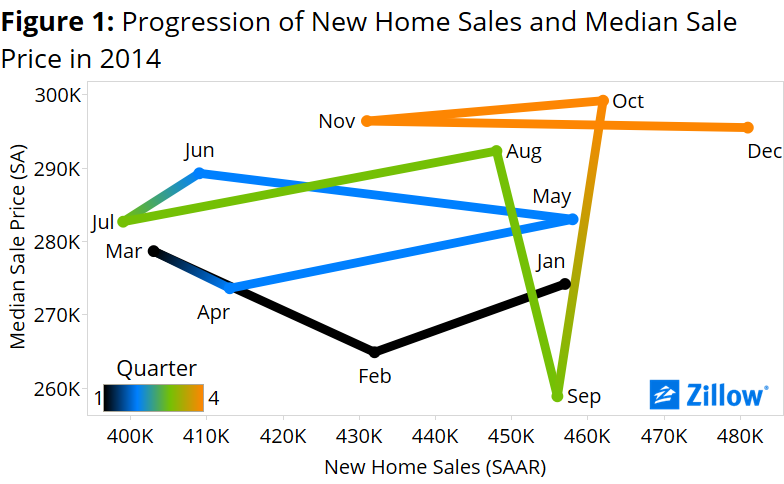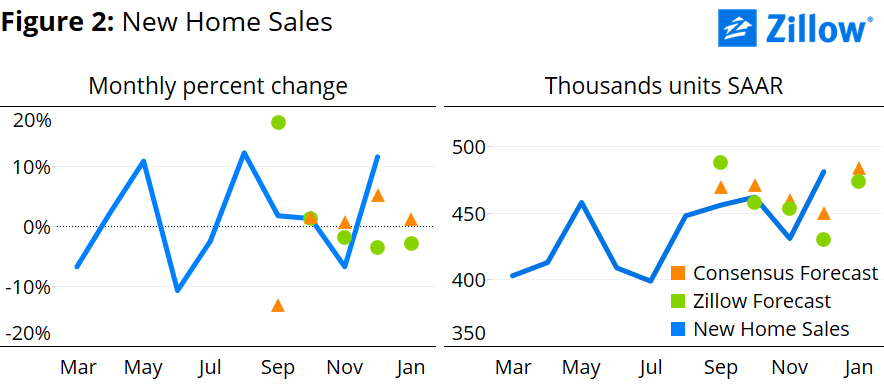- Zillow expects new home sales to fall 1.5 percent to 474,000 units (SAAR) in January.
- The combination of falling interest rates and gradually improving mortgage credit availability is expected to be offset by rising prices and a falling homeownership rate.
- The effects of the large unexpected increase in December’s new home sales is expected to wash out, leaving home sales lower than December.
Zillow expects Wednesday’s new home sales data from the U.S. Census Bureau to show a month-over-month decrease of about 1.5 percent to a seasonally adjusted annual rate (SAAR) of 474,000 units in January, down from 481,000 units (SAAR) in December.
2014: Year in Review
 New home sales are typically much more volatile month-to-month than existing home sales, but 2014 turned out to be a mild year, with volatility at only about half its historical average since 1999.[i] We examined the progression of new home sales and the median sale price of new homes in 2014 from the perspective of a supply and demand framework (figure 1). This figure definitely illustrates the volatility of new home sales compared to existing home sales. The equilibrium point exhibits large side-to-side swings, corresponding to large monthly changes observed in new home sales, but a general upward trend in prices throughout the year.
New home sales are typically much more volatile month-to-month than existing home sales, but 2014 turned out to be a mild year, with volatility at only about half its historical average since 1999.[i] We examined the progression of new home sales and the median sale price of new homes in 2014 from the perspective of a supply and demand framework (figure 1). This figure definitely illustrates the volatility of new home sales compared to existing home sales. The equilibrium point exhibits large side-to-side swings, corresponding to large monthly changes observed in new home sales, but a general upward trend in prices throughout the year.
Sales fluctuated around an average of 437,000 homes (SAAR) but ended the year on a particularly positive note, jumping 11.6 percent month-over month in December and 8.8 percent year-over-year to 481,000 units (SAAR). Sales reached their lowest point in July, at 399,000 units (SAAR). Despite these fluctuations in volumes, the median sales price of new homes rose at a fairly constant pace, ending December up 8.3 percent year-over-year to a seasonally adjusted $295,500.
Interest rates on a 30 year fixed-rate mortgage fell steadily last year and continued to decline into January, falling to 3.71 percent, down 72 basis points from a year ago[ii]. Lower interest rates typically support demand, but they provided little if any boost to sales over the year.
The share of loans in foreclosure declined in the third quarter of last year[iii], from about 4.4 percent to 3.9 percent. This should indicate a higher demand for new home sales, as fewer foreclosure re-sales are available to buyers who might otherwise have considered a new home. However, the downward trend in the homeownership rate likely tempered any of these improvements in demand. After stabilizing somewhat in the second quarter, the homeownership rate continued its years-long decline, falling at a fairly constant pace of 0.11 percentage points over the last half of 2014.
If mortgage rates remain low and the share of loans in foreclosure continues to decline, demand for new homes should be strong at the start of 2015. Single-family home starts trended up last year, rising 7.9 percent year-over-year. Given that it takes about five months on average for a new home to be completed and ready for sale[iv] and recent increases in housing starts, new home sales have the potential to make some gains in 2015.
January Forecast
Our new home sales forecast uses a best-fit combination of two models, a structural model and a historical model. Both models point toward lower home sales in January, although the structural model suggests a smaller decrease.
The structural model suggests almost no change in new home sales: a decrease of 0.1 percent to 480,000 units (SAAR). Recent changes in the underlying fundamentals are expected to cancel each other out, leaving new home sales near their December level.
The historical model suggests a larger decrease of 1.6 percent to 473,000 units (SAAR). Changes in single-family housing starts over the period from May to September, and the fact that large swings in new homes sales tend to even out, should result in a downward movement in sales for January.
Using a best-fit combination of the two models, we obtain a point forecast of 4.93 million units (SAAR), a decline of about 1.5 percent from December.
More details about our new home sales forecast methodology can be found here.
[i] Volatility is measured as the variance of monthly changes.
[ii] According to Primary Mortgage Market Survey data provided by Freddie Mac.
[iii] According to the MBA National Mortgage Delinquency Survey.
[iv] According to the U.S. Census Bureau.
